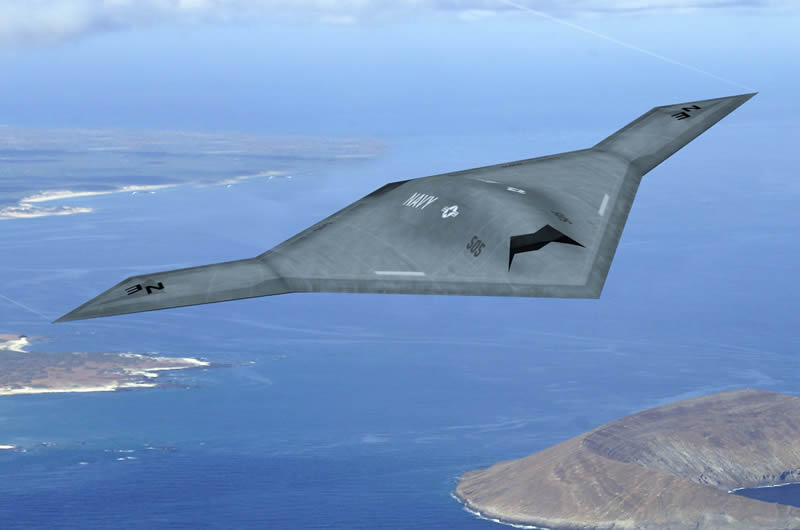- X-47 Pegasus
infobox Aircraft
name = X-47 Pegasus
type =Unmanned Combat Aerial Vehicle
manufacturer =Northrop Grumman 
caption = Northrop Grumman X-47B
designer =
first flight = February 2003
introduction =
retired =
status =
primary user =United States Navy
more users =
produced = 2003 -January 13 ,2006
number built =
program cost=
unit cost =
developed from =
variants with their own articles =The
Northrop Grumman X-47 Pegasus is a demonstration Unmanned Combat Aerial Vehicle. The X-47 began as part of DARPA's J-UCAS project, and is now part of theUnited States Navy 's UCAS-D program to create a carrier-based unmanned aircraft.Unlike the
Boeing X-45 , Pegasus development was company-funded. The initial vehicle carries the designation X-47A; the follow-on naval version is designated X-47B.The proof-of-concept X-47A vehicle was built under contract by
Burt Rutan 'sScaled Composites at theMojave Spaceport . The roll out ceremony at Mojave was in July 2001 and the first flight was successfully completed in February 2003. The program was terminated onJanuary 13 ,2006 as part of the US Military'sQuadrennial Defense Review .History
The US Navy did not commit to practical UCAV efforts until mid-2000, when the service awarded contracts of US$2 million each to
Boeing andNorthrop Grumman for a 15-month concept-exploration program. [ [http://www.defenselink.mil/releases/release.aspx?releaseid=2527 "DARPA And Navy Select Naval UCAV Contractors"] , US DoD, 20 June 2000.]Design considerations for a naval UCAV included dealing with the corrosive salt-water environment, deck handling for launch and recovery, integration with command and control systems, and operation in a carrier's high electromagnetic interference environment. The Navy was also interested in using their UCAVs for reconnaissance missions, penetrating protected airspace to identify targets for the attack waves.
The Navy went on to give Northrop Grumman a contract for a naval UCAV demonstrator with the designation of "X-47A Pegasus", in early 2001. The Pegasus demonstrator looks like a simple black arrowhead with no vertical tailplane. It has a leading edge sweep of 55 degrees and a trailing edge sweep of 35 degrees. The demonstrator has retractable tricycle landing gear, with a one-wheel nose gear and dual-wheel main gear, and has six control surfaces, including two elevons and four "inlaids". The inlaids are small flap structures mounted on the top and bottom of the wing forward of the wingtips.
Pegasus is powered by a single
Pratt & Whitney Canada JT15D-5C small high-bypass turbofan engine with 3,190lbf (14.2 kN) thrust. This engine is currently in use with operational aircraft such as theAermacchi S-211 trainer. The engine is mounted on the demonstrator's back, with the inlet on top behind the nose. The inlet duct has a serpentine diffuser to prevent radar reflections off the engine fan. However, to keep costs low, the engine exhaust is a simple cylindrical tailpipe, with no provisions for reducing radar or infrared signature.The UCAV's airframe is built of composite materials, with construction subcontracted out to Burt Rutan's
Scaled Composites company, which had the expertise and tooling to do the job cheaply. The airframe basically consists of four main assemblies, split down the middle with two assemblies on top and two on bottom.The Pegasus was rolled out on
30 July 2001 and performed its first flight on23 February 2003 at the US Naval Air Warfare Center at China Lake, California. The flight test program did not involve weapons delivery, but Pegasus does have two weapons bays, one on each side of the engine, that may be each loaded with a single 500 pound(225 kilogram) dummy bomb to simulate operational flight loads. The Pegasus was also used to evaluate technologies for carrier deck landings, though the demonstrator did not have an arresting hook. Other issues related to carrier operations involve adding deck tie-downs without compromising stealth characteristics, and designing access panels so that they wouldn't be blown around or damaged by strong winds blowing across the carrier deck.pecifications (X-47A)
aircraft specifications
plane or copter?=plane
jet or prop?=jetcrew=none
length main= 19 ft 7 in
length alt= 8.50 m
span main= 19 ft 6 in
span alt= 8.47 m
height main= 6 ft 1 in
height alt= 1.86 m
area main= ft²
area alt= m²
empty weight main= 3,836 lb
empty weight alt= 1,740 kg
loaded weight main= 4,877 lb
loaded weight alt= 2,212 kg
max takeoff weight main= 5,903 lb
max takeoff weight alt= 2,678 kgengine (jet)=
Pratt & Whitney JT15D-5C (X-47A)
Pratt & Whitney F100-220 (X-47B)
type of jet= turbofan
number of jets= 1
thrust main= 3,190 lbf
thrust alt= 14.2 kNmax speed main= "high subsonic"
max speed alt=
cruise speed main= "high subsonic"
cruise speed alt=
range main= 1,500+ NM
range alt= 2,778+ km
ceiling main= 40,000+ ft
ceiling alt= 12,192+ m
climb rate main= ft/min
climb rate alt= m/s
loading main= lb/ft²
loading alt= kg/m²
thrust/weight= 0.65armament=None (ISR)
ee also
aircontent
related=similar aircraft=
sequence=
X-44 -
X-45 -
X-46 -X-47 -
X-48 -
X-49 -
X-50lists=
*List of experimental aircraft References
External links
* [http://www.is.northropgrumman.com/systems/nucasx47b.html X-47B UCAS page on northropgrumman.com]
* [http://www.is.northropgrumman.com/systems/nucasx47b_gallery.html X-47B Media Gallery on northropgrumman.com]
* [http://www.airforce-technology.com/projects/x47/ Detailed X-47 page on AirForce-Technology.com]
* [http://seattletimes.nwsource.com/html/businesstechnology/2002838115_roboticplane02.html "Boeing's robotic plane: All ready, but homeless", Seattle Times]
Wikimedia Foundation. 2010.
